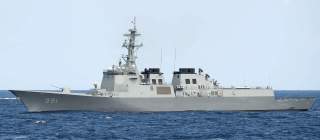Can South Korea’s New Aegis Destroyers Shoot Down North Korean Missiles?
We take a look?
South Korea is building new Aegis destroyers that could be used to shoot down North Korean ballistic missiles.
The Defense Acquisition Program Administration, or DAPA, approved the Korea Destroyer Next Generation project. The initial goal is to locally develop the destroyer by the late 2020s, with an initial budget of $1.6 billion.
“Seoul plans to deploy six KDDX destroyers by the mid or late 2030s,” according to UPI. “The total cost of developing and producing the six vessels is expected to top $6.2 billion, observers said.”
The South Korean Navy has also signed a $366 million contract with Lockheed Martin to buy an upgraded Aegis BMD (Ballistic Missile Defense) system for its Sejong the Great-class Aegis destroyers. The Baseline 9.C2 Aegis system, which includes an advanced SPY-1D(V) radar, is designed to stop both air and missile threats. “Three KDX-III Aegis equipped ships, also known as the King Sejong the Great class, are the largest destroyers to carry the Aegis Combat System,” according to Lockheed Martin. In addition, South Korea is already planning to buy an additional $300 million worth of SM-2 air defense missiles. And the U.S. State Department recently approved the purchase of sixty Patriot Advanced Capability-3 Missile Segment Enhancement (PAC-3 MSE) missiles.
"The KDDX is a project to procure destroyers for the purpose of safeguarding maritime interests and responding to potential disputes at sea," said a DAPA press release. But given South Korea’s justified nervousness over North Korean ballistic missile attack, it seems likely that they will be used for missile defense, just like America’s Arleigh Burke-class Aegis destroyers.
The powerful and versatile 8,000-ton Arleigh Burke destroyers appeared at the end of the Cold War as air defense ships equipped with Aegis, a sophisticated air defense system comprising powerful radars and Standard SM-2 surface-to-air missiles, as well as Tomahawk cruise missiles and anti-submarine weapons. That in itself would make them formidable enough, but it turns out that Aegis and the Standard anti-aircraft missile could be modified to shoot down ballistic missiles. As of February 2018, the United States had thirty-five Aegis Ballistic Missile Defense ships, most of them Arleigh Burke destroyers.
As the nation most likely to be hit by North Korean ballistic missiles, South Korea is very interested in missile defense. “BMD coverage of South Korea is centered on engaging missiles in the terminal phase of flight,” according to the Arms Control Association. “U.S. and ROK [Republic of Korea] forces operate several U.S.-made BMD platforms on the peninsula to defend against short- and medium-range North Korean missiles, including a U.S.-operated THAAD battery and several U.S.- and ROK-operated Patriot batteries on land. South Korea is developing several indigenous short-range BMD systems, under its Korean Air and Missile Defense (KAMD) system scheduled to be deployed by the early 2020s. U.S. and South Korean Aegis BMD ships also patrol South Korean waters.”
South Korea also wants to make sure that its KDDX Aegis destroyers can seamlessly operate with U.S. warships, which would be a key part of joint missile defense. DAPA “also approved a plan to upgrade the Link 16, a tactical data link system installed on warplanes or warships to ensure the smooth sharing of information with the U.S. military during training or other combined operations,” UPI said. “To upgrade it, Seoul will purchase an enhanced encryption device through a government-to-government foreign military sale program with Washington. Three U.S. defense firms are expected to vie for the project, worth $355 million, to procure the device by the mid-2020s.”
Michael Peck is a contributing writer for the National Interest. He can be found on Twitter and Facebook.
Image: Wikimedia

